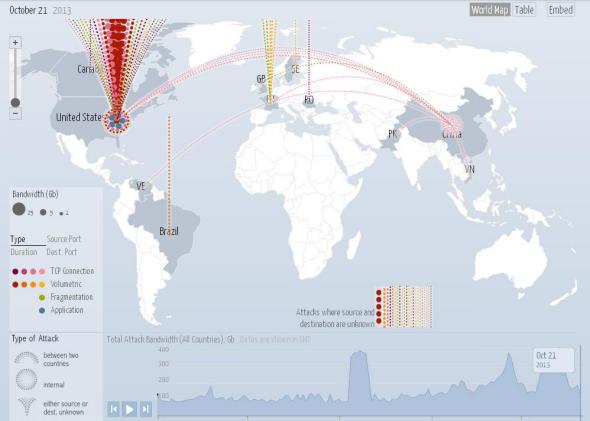Google's New Map of Global Cyber-Attacks Is Nifty, But Is It Also Self-Serving?
As part of a summit on cyber-conflict today, Google and Arbor Networks released a map (see above) that visualizes major cyber attacks around the world as they happen. Specifically, the map tracks distributed denial-of-service attacks (DDoS for short), in which a large number of machines work together to overload or otherwise foul up a given Web server. The goal is generally to take a website or Web service offline, or slow it down to the point of unusability.
Explaining the visualization tool, Google frames DDoS attacks as assaults on free speech and democracy:
Distributed Denial of Service (DDoS) attacks can be used to make important online information unavailable to the world. Sites covering elections are brought down to influence their outcome, media sites are attacked to censor stories, and businesses are taken offline by competitors looking for a leg up. Protecting access to information is important for the Internet and important for free expression.
That's all true. But Google neglects to mention that DDoS attacks are also commonly used by dissidents as a means of political protest. In a 2010 Slate piece, Evgeny Morozov explored their potential as a legitimate form of civil disobedience in light of a series of high-profile attacks by the hacker collective Anonymous. (Morozov concludes that Anonymous' attacks didn't meet that standard, but that other types of DDoS attacks might.)
Google, however, sees no gray areas here. Its map is pitched as part of a new array of "free expression tools" offered from the goodness of its corporate heart for the benefit of mankind at large. No doubt there is some altruism involved here. But it's also not hard to see how one of the world's largest and most profitable Internet companies might have a vested interest in lumping all disruptions of smooth Internet service together as "attacks on free speech," as Google Ideas director Jared Cohen does in a blog post introducing the tool. At best, the framing is lazy and simplistic. At worst, it's a disingenuous and self-serving sleight of hand.
None of which changes the fact that, solely as a visualization tool, the map is pretty nifty. Again, the real-time map is here. And here are a few snapshots that Google and Arbor Networks posted to highlight significant recent spikes in attacks targeting or originating from various countries.
Future Tense is a partnership of Slate, New America, and Arizona State University.


